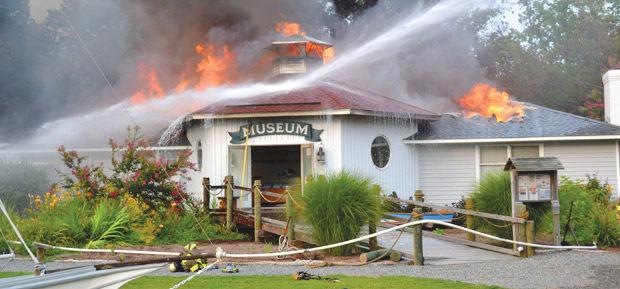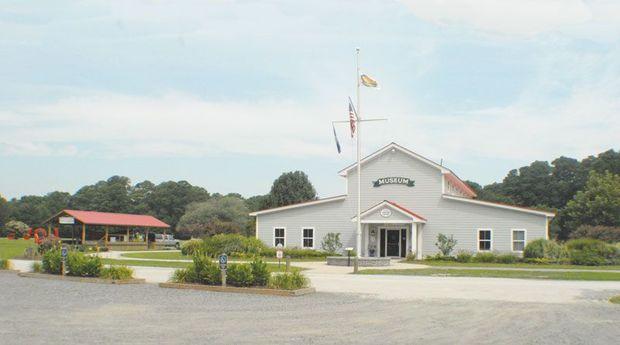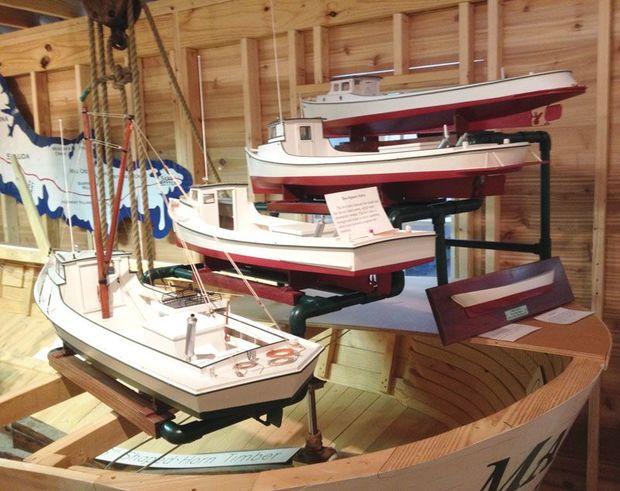The idea of a maritime museum in Deltaville, VA, got its start in 2000 when Ms. Pette Clarke donated her home to be used as a museum. The late Gene Ruark, in league with Raynell Smith, Steve Smith, aka Captain Krunch, and others collected artifacts large and small, campaigned for funds, and brought to life, over a period of 12 years, a repository for the rich maritime history of Deltaville.

Tragedy struck on a warm summer evening at 6:30 p.m., July 18, 2012, when a fire of unknown origin raged through the museum destroying treasured artifacts and nearby boats. Boats that were being built during the museum family boat building week event were all burnt. It was a bleak scene that following morning when the still smoldering remains of the museum offered the realization that in the space of a few hours, the years of work and thousands of volunteer hours along with irreplaceable artifacts had gone up in smoke.
The burnt remains of the buildings and artifacts were not yet cold when pledges to rebuild were heard from mourners viewing the ashes. At first they considered rebuilding, and then a new and greater museum and a separate event pavilion were born. Bob LeBoeuf, director of the Deltaville Maritime Museum, said that just five months after the fire, they broke ground on the new events pavilion. Volunteers with an average age of 70 years were largely responsible for the labor. In 2013, the new museum was built, separate from the events building. Member Bob Walker suggested the Old Red Barn Hotel on Stingray Point should be the inspiration for the new museum. Ironically a new insurance policy, written just a month before the fire, combined with fundraising and grants provided funds to rebuild.

Central to the new museum is an authentic half-scale skipjack fully rigged with sails hoisted. LeBoeuf said there are some 65 boat builders for whom the museum ultimately will provide information. To accomplish this, LeBoeuf has created interactive electronic displays where unlimited information can be stored and easily retried. The first electronic display involved 85 lighthouses that existed on the Chesapeake Bay. The same system will be used to expand the available information about the many watermen tools displayed in the simulated boat shop. The boat shop houses a large cutaway model of a typical deadrise boat.
In his passion to tell the full story of the maritime history of the area, Bob LeBoeuf has plans to tell the story of the transition from log built boats and plank built boats, including the story of how the first saw mill built by the Wood Brothers in 1903 changed the way boats were built. For the first time, wood planks were readily available to boatbuilders. No longer did they have to shape the logs using a hand or foot adze. They no longer needed to saw the logs by hand. Building with planks saved an enormous amount of time. In fact, one of the Wood Brother’s massive sawmill blades is on display in the museum.

The Deltaville Maritime Museum has truly risen up out of the ashes and is now hard at work keeping the tradition and history of the “Boat Building Capital of the Chesapeake.” Talented volunteers maintain, restore, and build historically accurate vessels. One outstanding example is the painstaking restoration by John England and volunteers who contributed 8500 hours to the restoration of the buyboat F.D. Crockett. Hardly recognizable as a boat when she arrived, the restored 62.8-foot F.D. Crockett is a working display and has been named to the Virginia Landmarks Register and the National Historic Register.
In addition to providing a historical record of watermen in the area, the new museum hosts weddings and other events. Every year, Family Boat Building Week provides an opportunity for families to build a Wright Skiff and actually use it on the water all in one week. The replica shallop Explorer, built at the museum, tours the Bay telling the story of John Smith.
Looking back at what remained of the Deltaville Maritime Museum after the fire in 2012, it is truly amazing to see the new museum, the events pavilion, the waterfront, and Holly Point Park. It is no dusty old museum; it is a dynamic center for the whole community, a place to learn more about the rich maritime history of the Chesapeake Bay and a place to enjoy good music, great food, and some truly wonderful people. For more about the Deltaville Maritime Museum, visit
deltavillemuseum.com or call (804) 776-7200.
by Bob Cerullo Tragedy struck on a warm summer evening at 6:30 p.m., July 18, 2012, when a fire of unknown origin raged through the museum destroying treasured artifacts and nearby boats. Boats that were being built during the museum family boat building week event were all burnt. It was a bleak scene that following morning when the still smoldering remains of the museum offered the realization that in the space of a few hours, the years of work and thousands of volunteer hours along with irreplaceable artifacts had gone up in smoke.
The burnt remains of the buildings and artifacts were not yet cold when pledges to rebuild were heard from mourners viewing the ashes. At first they considered rebuilding, and then a new and greater museum and a separate event pavilion were born. Bob LeBoeuf, director of the Deltaville Maritime Museum, said that just five months after the fire, they broke ground on the new events pavilion. Volunteers with an average age of 70 years were largely responsible for the labor. In 2013, the new museum was built, separate from the events building. Member Bob Walker suggested the Old Red Barn Hotel on Stingray Point should be the inspiration for the new museum. Ironically a new insurance policy, written just a month before the fire, combined with fundraising and grants provided funds to rebuild.
Tragedy struck on a warm summer evening at 6:30 p.m., July 18, 2012, when a fire of unknown origin raged through the museum destroying treasured artifacts and nearby boats. Boats that were being built during the museum family boat building week event were all burnt. It was a bleak scene that following morning when the still smoldering remains of the museum offered the realization that in the space of a few hours, the years of work and thousands of volunteer hours along with irreplaceable artifacts had gone up in smoke.
The burnt remains of the buildings and artifacts were not yet cold when pledges to rebuild were heard from mourners viewing the ashes. At first they considered rebuilding, and then a new and greater museum and a separate event pavilion were born. Bob LeBoeuf, director of the Deltaville Maritime Museum, said that just five months after the fire, they broke ground on the new events pavilion. Volunteers with an average age of 70 years were largely responsible for the labor. In 2013, the new museum was built, separate from the events building. Member Bob Walker suggested the Old Red Barn Hotel on Stingray Point should be the inspiration for the new museum. Ironically a new insurance policy, written just a month before the fire, combined with fundraising and grants provided funds to rebuild.
 Central to the new museum is an authentic half-scale skipjack fully rigged with sails hoisted. LeBoeuf said there are some 65 boat builders for whom the museum ultimately will provide information. To accomplish this, LeBoeuf has created interactive electronic displays where unlimited information can be stored and easily retried. The first electronic display involved 85 lighthouses that existed on the Chesapeake Bay. The same system will be used to expand the available information about the many watermen tools displayed in the simulated boat shop. The boat shop houses a large cutaway model of a typical deadrise boat.
In his passion to tell the full story of the maritime history of the area, Bob LeBoeuf has plans to tell the story of the transition from log built boats and plank built boats, including the story of how the first saw mill built by the Wood Brothers in 1903 changed the way boats were built. For the first time, wood planks were readily available to boatbuilders. No longer did they have to shape the logs using a hand or foot adze. They no longer needed to saw the logs by hand. Building with planks saved an enormous amount of time. In fact, one of the Wood Brother’s massive sawmill blades is on display in the museum.
Central to the new museum is an authentic half-scale skipjack fully rigged with sails hoisted. LeBoeuf said there are some 65 boat builders for whom the museum ultimately will provide information. To accomplish this, LeBoeuf has created interactive electronic displays where unlimited information can be stored and easily retried. The first electronic display involved 85 lighthouses that existed on the Chesapeake Bay. The same system will be used to expand the available information about the many watermen tools displayed in the simulated boat shop. The boat shop houses a large cutaway model of a typical deadrise boat.
In his passion to tell the full story of the maritime history of the area, Bob LeBoeuf has plans to tell the story of the transition from log built boats and plank built boats, including the story of how the first saw mill built by the Wood Brothers in 1903 changed the way boats were built. For the first time, wood planks were readily available to boatbuilders. No longer did they have to shape the logs using a hand or foot adze. They no longer needed to saw the logs by hand. Building with planks saved an enormous amount of time. In fact, one of the Wood Brother’s massive sawmill blades is on display in the museum.
 The Deltaville Maritime Museum has truly risen up out of the ashes and is now hard at work keeping the tradition and history of the “Boat Building Capital of the Chesapeake.” Talented volunteers maintain, restore, and build historically accurate vessels. One outstanding example is the painstaking restoration by John England and volunteers who contributed 8500 hours to the restoration of the buyboat F.D. Crockett. Hardly recognizable as a boat when she arrived, the restored 62.8-foot F.D. Crockett is a working display and has been named to the Virginia Landmarks Register and the National Historic Register.
In addition to providing a historical record of watermen in the area, the new museum hosts weddings and other events. Every year, Family Boat Building Week provides an opportunity for families to build a Wright Skiff and actually use it on the water all in one week. The replica shallop Explorer, built at the museum, tours the Bay telling the story of John Smith.
Looking back at what remained of the Deltaville Maritime Museum after the fire in 2012, it is truly amazing to see the new museum, the events pavilion, the waterfront, and Holly Point Park. It is no dusty old museum; it is a dynamic center for the whole community, a place to learn more about the rich maritime history of the Chesapeake Bay and a place to enjoy good music, great food, and some truly wonderful people. For more about the Deltaville Maritime Museum, visit deltavillemuseum.com or call (804) 776-7200.
by Bob Cerullo
The Deltaville Maritime Museum has truly risen up out of the ashes and is now hard at work keeping the tradition and history of the “Boat Building Capital of the Chesapeake.” Talented volunteers maintain, restore, and build historically accurate vessels. One outstanding example is the painstaking restoration by John England and volunteers who contributed 8500 hours to the restoration of the buyboat F.D. Crockett. Hardly recognizable as a boat when she arrived, the restored 62.8-foot F.D. Crockett is a working display and has been named to the Virginia Landmarks Register and the National Historic Register.
In addition to providing a historical record of watermen in the area, the new museum hosts weddings and other events. Every year, Family Boat Building Week provides an opportunity for families to build a Wright Skiff and actually use it on the water all in one week. The replica shallop Explorer, built at the museum, tours the Bay telling the story of John Smith.
Looking back at what remained of the Deltaville Maritime Museum after the fire in 2012, it is truly amazing to see the new museum, the events pavilion, the waterfront, and Holly Point Park. It is no dusty old museum; it is a dynamic center for the whole community, a place to learn more about the rich maritime history of the Chesapeake Bay and a place to enjoy good music, great food, and some truly wonderful people. For more about the Deltaville Maritime Museum, visit deltavillemuseum.com or call (804) 776-7200.
by Bob Cerullo